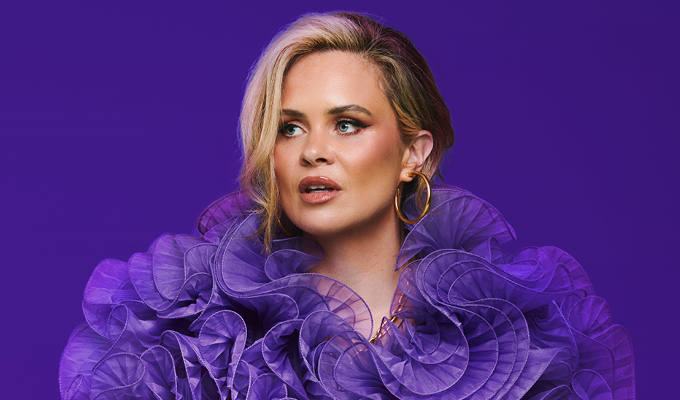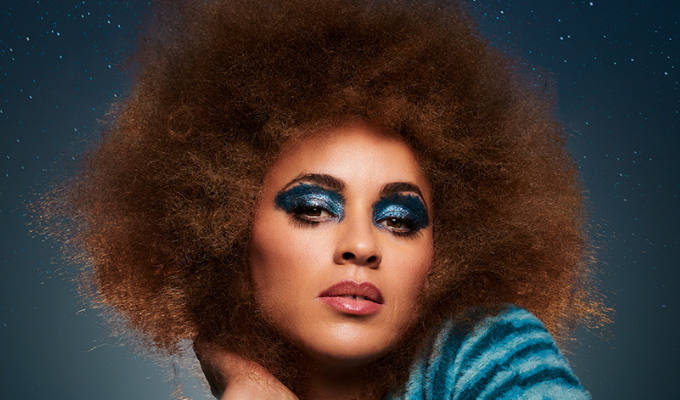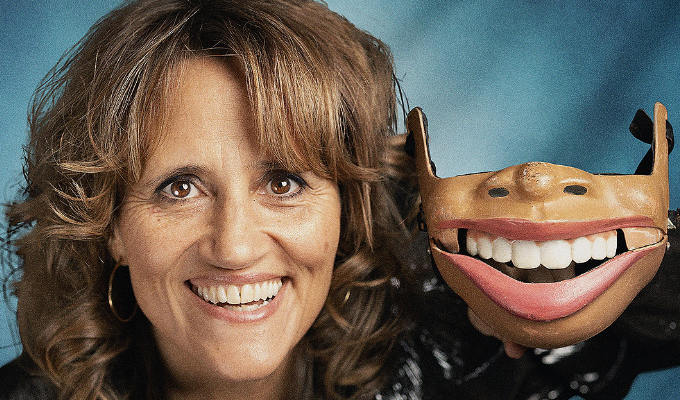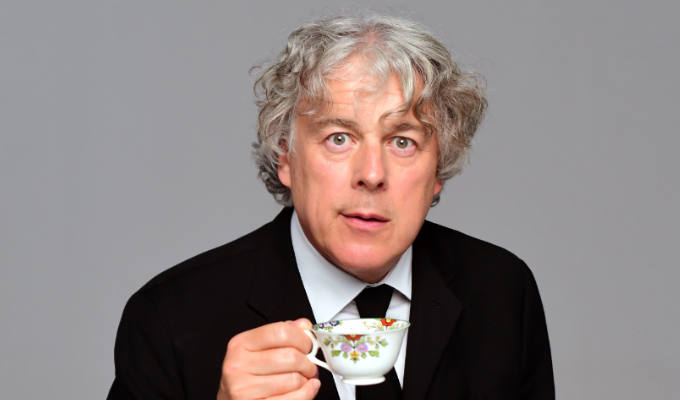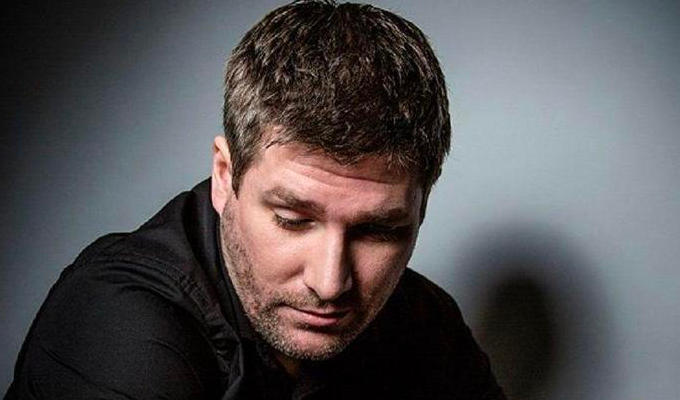Our manifesto
Stewart Lee explains all about the Alternative Comedy Experience
The Alternative Comedy Experience, a new stand-up series, starts on Comedy Central tomorrow night. I am executive producer of the show, curated the selection of acts, appear interviewing them backstage, and am obliged to promote the programme.
So here I am, heading direct into the heartland of the comedy cognoscenti on Chortle, with a point by point description of the process and intentions of The Alternative Comedy Experience, too detailed, dull, nuanced, and niche to ever see print in a newspaper. Warning: contains spoilers.
For the first and second series of Stewart Lee’s Comedy Vehicle we were required to provide extra content for BBC on-line and the red button channel. The producer Richard Webb and I decided to use my existing stage set to spend the last night of filming of each series, shooting stand-ups I liked who were perhaps too quirky, cerebral, unknown, independent or strange to get slots on the mainstream television stand-up shows, including Stephen Carlin, Henning Wehn, Andrew O’Neill, Kevin Eldon’s character stuff, and Paul Sinha.
Pleased with the results, we pitched the idea of me fronting a similarly themed series to BBC2 or BBC4 but never heard anything back from anyone about the idea. Bear that in mind, internet commentators who imagine known comics have a hotline to the decision process.
At the same time, Colin Dench, a punk era promoter and comedy maven from Southend, who produced my last few live DVDs, was experiencing unnamable stirrings. Dench had been struck by the sense of an ever-widening gap between his experience of sets by the sort of acts you’d find on the Edinburgh Fringe doing solo shows at, say, comedy fans’ favorite space The Stand, and the content of mainstream television stand-up shows, even when that content is provided by the sort of act you might see at The Stand.
Enamored by the unique atmosphere of that particular cave-like venue, described to me by a visiting American comedian as the place ‘where all that art comedy happens’, Dench took Tim Kirkby and John Walker, who were the director and director of photography on Comedy Vehicle and my live DVDs, to The Stand. They wanted to see the room with a view to asking permission to film there, and Dench, who is teetotal, began to outline his tea-inspired vision of documenting, not necessarily for television, a different form of stand-up experience, for punter and performer, than that offered on Apollo and Roadshow.
Surprisingly, the cable channel Comedy Central were interested but, I suspect needed a sweetener. I was asked on board, I have no doubt, merely in a misguided attempt to give the project some kind of marketing and promotion angle, and it has worked. Do you think you would be reading this if a teetotal man called Colin Dench from Southend had written it? No. I said I would help out as long as my name wasn’t in the title, and I didn’t introduce the acts in the show.
I wouldn’t feel comfortable bringing on, under my name, the sort of people who regularly actually inspire me, as if I were delivering them to the viewer by the grace of my god-like hand. And I felt like the absence of a comic’s name in the title helped to democratise the programme, and differentiate it from McIntyre’s Roadshow, where the implication is that he is the star and is better than the guests.
Also, Comedy Central weren’t about to pay me enough to put my name on the product anyway, although lazy journalists everywhere are calling the finished show Stewart Lee’s Alternative Comedy Experience, so that hasn’t worked. (For the record, I received less for working on the series than Hal Cruttenden does for a corporate gig, according to BBC2’s Funny Business documentary.)
Even before the series was christened, we imagined we should be striving towards some kind of loose overview of the other styles of stand-up that are, and perhaps always have been, available, but are not currently favored by the big TV showcases. I insisted on a final say in the line-up, as it was going to be my face fronting the thing out, although appreciated some compromises would have to be made as we thrashed around an original long-list of 60 or so names to the essence of what we thought defined this ‘alternative’ strand of stand-up, and which would also be acceptable to Comedy Central, whose commitment to the idea already seen them going out on a long limb.
Advertiser-dependent Comedy Central has to be ratings driven, and is understandably obsessed with maintaining the 18-32 year old market popular with the products that fund it. This is how broadcasting works, the BBC excepted, and it’s why we mustn’t allow the Right, and its friends in the communications business, to close the BBC down, Savile and Sachsgate or not.
I am well aware that the tentative and delayed re-commissions of my own BBC series Comedy Vehicle were both only achieved as a result of the prestige the show was imagined to have bought to the channel, as the ratings were unspectacular. For some people, rightly or wrongly, there is a perception that Comedy Vehicle was what BBC2 ought to be doing, and so it was eventually returned.
But you can’t live on prestige, and Comedy Central does not have the luxury of allowing the clanging bell of hollow praise to be a factor in its commissioning process, (although I fondly imagine they will be pleased with the good advance word on the series so far, ratings aside.) We have been criticized on the internet for the lack of ‘new’ talent in the show, but we never wanted the talent to be exclusively ‘new’, and any quotes saying we did are inaccurate glosses of my words.
Indeed, if I’d had full reign there would have been more septuagenarians and twenty-somethings in the bills. But Comedy Central, already making a bold programming decision by their standards, needed our show to draw audiences and were understandably nervous about alienating their core audience with elderly performers, and also about the obscurity and inexperience of some of the proposed younger ones – wrongly in my view, but I conceded.
Two acts we wanted, who remain conspicuously absent in a show claiming to be an overview of all the best working comics who fit the brief, turned us down, as I assumed they would. One big agent’s act teasingly told me the show was viewed as some kind of dangerous anarchist splinter group, that he would be ostracised for having appeared on. And I suspect larger agents, their eyes on the prize of the lucrative corporate gig market ensnared by acts’ appearances on the big shows, were worried about how their clients’ commercial standing would fare if they were filmed performing in a small room.
And the small room of Stand I was key to the show. In a small enough room you can feel different parts of a crowd respond differently, you can engage directly with an audience member two feet from you, and punters can feel a comic making choices in real time. Luckily, there was a team to hand with experience, from my live DVDs and Comedy Vehicle, of filming comedy in smaller spaces than we usually see on TV.
Tim Kirkby, director, and John Walker, director of photography, were essential to the project. Over the last five years both have enabled me to realise the mental rulebook I have been trying to follow in the filming of stand-up. I think stand-up is like juggling, home baking, or sex, in that one of the exciting things about it is the element that it is really happening and that things might go very badly wrong.
Too fussy an edit, with too many different shots, with cuts to too many different angles while a joke or story is being told, remind the viewer they are watching a post-produced construct, and takes them out of the moment. If possible you should be able to pick up audience responses in a wide shot in which you can also see the comic, so we know the response was genuine, rather than appended in the edit in the form of a cutaway to a laughing person.
If there are cutaways to individual audience members they should work against the grain of the performance, showing people who are unhappy, angry, confused or bored, to exaggerate the sense that something is at stake, that a risk is being taken. Extreme close-ups should be favored at the expense of massive wide shots, to force the viewer at home to think for themselves about what is being said and done, rather than giving them the false comfort of seeing a huge crowd all enjoying it, and suggesting by association that they should.
The content of the show should be appropriate to these camera moves. It is all about non-consensus. I appreciate it must be fun to be part of the party atmosphere that the mass-agreement, and mass-recognition, of a Peter Kay or Paddy McGuiness audience provokes (and I do really mean this). But another thing I think is great about stand-up is confusion, doubt, unease, the gradual sea change in a room as the stiffs come round to a point of view they had never considered, as they come to realise that the person they assumed was mad or incompetent really knows what they are doing, and when some of them are in tears while others are still silent.
We had seen all our chosen acts - whether by dint of their silliness, their strangeness, or their sheer smartness - have those effects on a room, as opposed to the instant consensus aimed at by the big TV stand-up shows, and we wanted to see it captured. On Comedy Central. Ideally after a repeat of Michael McIntyre’s Comedy Roadshow.
There’s a ‘70s ITV variety show, called The Wheeltappers’ and Shunters’ Social Club, set in a terrifyingly accurate studio-replica of an old-school Working Men’s Club, that also had that same vibe. I loved it as a child, when I was too young to baulk at Bernard Manning, and think I have spent my whole adult life trying to recreate it. It’s probably not a coincidence that Comedy Vehicle came to be filmed at The Mildmay Club, one of the last unspoiled Working Men’s Clubs left in London.
And another now hated Seventies show had been at the back of Colin Dench’s alcohol-free mind all along, - The Comedians. In this once massive ITV stand-up showcase, a talent pool of a dozen or so club comics in bowties performed to a studio audience, each drawing from the same shallow well of shared pub jokes, which were literally crossed off a blackboard in the wings by a production assistant as they were used up, to the dismay of whichever bow-tied racist had to go on last.
But it wasn’t the racism, sexism and homophobia that had drawn Colin Dench’s fertile mind to The Comedians. It was that the comics’ sets were snappily edited together, crossing from one gag to the next, and stripped across the series in an unrelenting cavalcade of bite-sized pre-Political Correctness laughs. Would this be a way of selling our alterno-acts to Comedy Central’s imagined viewership of no-attention span youngsters, and ringing another, if retrograde and reactionary, change to the current TV stand-up style?
By June last year the eventually 20-strong line-up of the still untitled show had solidified. Most TV stand-up shows lean heavily on acts represented by the management company that owns the production company that makes them, as Chortle’s deranged pie-charts showed yesterday. But internet types have said, in contrast, that although The Alternative Comedy Experience doesn’t just have acts from the usual three or four big agencies, it’s made up instead of all my friends.
It isn’t, and indeed some friends I proposed for the show were lost in the negotiations towards the final list, and some of the acts in the show are people who, though I love their work, make me feel uncomfortable, frightened, and paranoid, though I don’t actively dislike them as people. And 50 per cent of the acts, including most of the ones I know best, were on Dench’s ideal final squad before I was brought on broad. And two of them, Maeve Higgins and David Kay, were turns I’d never spoken to before. That said…. Admittedly, five of the acts - Stephen Carlin, Josie Long, Henning When, Tony Law and Eleanor Tiernan - are people I got to know well having asked them to come on the road opening for me for months at a time because I already liked their acts; and admittedly, I did once book a babysitter so I could go out on the town with Tony Law, but that one and only time I arranged to meet him socially he fell asleep and didn’t turn up; and admittedly, I went to see the group Giant Sand with Robin Ince once in the last century, but that was the only time we ever met out of work, and he didn’t like them anyway; and, admittedly, one of the five female performers is my wife of seven years, but as such can hardly be described as a ‘friend’; and Simon Munnery, admittedly, was at our wedding, but he hadn’t been invited. He just suspected there would be sausage rolls and arrived after everyone had gone to bed to lick the plates.
What defined these disparate performers, I suppose, was not that I knew some of them a bit, but that they are all the sort of acts, I think, that other comics stand at the back of the room admiring, irrespective of what audiences, critics and commissioners think of them. Should enough of you watch the series and we get another go, we will throw the net wider next time. We’ve a better gender mix than any other TV stand-up show ever, but in the event of a TACE 2 I’ll spend a summer seeing only Free Fringe acts for starters, and in addition to that hopefully we’ll be able to expand the age rage at both ends of the spectrum, and the cultural and international mix, testing the tolerance of Comedy Central’s X-Box-fingering young viewers to the max.
In July we went to The Stand in Edinburgh to film nearly two dozen acts in ten shows over five nights. John Walker lit the venue brilliantly, in such a way as it doesn’t look like it had been lit at all, and in the daytimes I began interviewing the acts backstage, to cut between their performances in lieu of a big Roadshow style build-up intro. In the familiar surroundings of the cosy backstage cupboard of their favorite venue, The Stand, most people enjoyed relaxed, candid and charming conversations, somewhere between a therapy session and those Graham Norton-type interviews where he feeds set-ups to people whose material he’s read up on.
I did some great fake spontaneous TV chat-show style riffs with Simon Munnery, my backwards knowledge of his back catalogue allowing me to set him up perfectly for his best lines. I got in deep with Dave O’Doherty on comedy theory. Interviewing my wife was the most awkward moment in our relationship since the cheese grater incident. And the former Butlins Red Coat Boothby Graffoe gave away nothing, and remained resolutely ‘on’ throughout, peppering his Christmas cracker gag-reliant chat with tiresomely forced zingers about my increasing weight and deteriorating appearance.
Everyone’s performances on Monday and Tuesday and Friday went brilliantly in both the 7pm and 10pm recordings, the venue itself almost seemed like the star of the show, and Phil Nichol delivered a spontaneously, and massively, extended career-defining set of all his old club set material that I hope one day everyone will be able to see in its entirety. But the early mid-week shows on Wednesday and Thursday revealed an unforeseen problem that slightly derailed those two recordings, and cost us a couple of potentially great performances.
While most of the tickets for most of the shows went to comedy-savvy Stand regulars or fans of the individual performers themselves, we used a TV audience supply company to fill the remainder of the 140 seats. For the early shows on Wednesday and Thursday the majority of the room ended up comprising people who like TV comedy, provided by the audience supply company, and not surprisingly, they struggled with material that Stand regulars would have processed more readily. How do you sell a show that aims to be different to TV stand-up to people who have come along to see TV stand-up?
Robin Ince, like the club hack that he secretly is, somehow sold them a set of quantum physics based observational comedy, that I’ve seen re-aligning the horizontal plane of a Hammersmith Apollo full of science buffs, but both those early shows were a slog for the acts. Nonetheless, we used much of the footage. There’s something satisfying about seeing a comic’s look of disappointment in the audience when a line other comedians, and probably even some TV viewers at home, can tell is brilliant, is met with a degree of bafflement by the squares in the room.
We wanted the show to reflect accurately the comedians’ experience of performing, and part of that experience is the struggle, I suppose. But if there’s a series two though I will lobby to only allow in audience members who can prove they haven’t even got a TV licence, thus ensuring some degree of quality.
Negotiations about the title were fraught. I hoped it could include the word ‘Alternative’ precisely because, in comedy, I remember when ‘Alternative Comedy’, the post-punk movement that changed the rules in British humour and gave you pretty much everything you value today, became a perjorative term. ‘Alternative comedy?’, Jim Bowen said to David Baddiel on daytime TV in 1989, ‘It’s the alternative to comedy.’ Also, irrespective of dictionary definitions of what ‘alternative comedy’ was or is, we were at least offering an alternative to the way most stand-up comedy on TV is presented today.
And suddenly there seems to be enough of a groundswell of discontent with panel show and stand-up showcase comedy to suggest that it was time to actively embrace this debased and hated term, ‘alternative comedy’. And ‘experience’ seemed like a good word to have in there because the show was shot in such a way as to emphasise the unique nature of the one-off performances we’d captured, and to give you a flavor of what it might be like to be there. But we couldn’t get that idea past Comedy Central. Until the rough edits began to come together. Then everything changed.
On the editing suite monitor it seemed, to me at least, that the show’s line-up belonged together. Even though they offered approaches as diverse as the left-wing or feminist polemic of Josie Long and Bridget Christie respectively, and the arch reactionary rationalism of Henning Wehn or Glenn Wool; as the superb silliness of David Kay and Maeve Higgins and the brutal logical reasoning of Andy Zaltzman and Robin Ince; as the charming indie-folk stylings of Isy Suttie and the one-string freak-noodling of Simon Munnery; as the deadpan minimalism of Eleanor Tiernan and David O’Doherty and the frenzied agitation of Phil Nichol, they belonged together by virtue of what they were not - safe, packaged, and predictable.
Acts like Paul Sinha and Alun Cochrane, who have the range of talent to be able to do extended one-man shows in arts centres and yet also to appear before the stag parties of The Comedy Store, (which I couldn’t), were able to show sides of themselves not visible on The Chase or Mock The Week respectively. And they seemed to sit alongside equally talented, but more problematically strange, turns like Tony Law and Sam Simmons. And Boothby Graffoe, whose lineage stretches back to the pre-Alternative Comedy folk-circuit humorists like Mike Harding or Jake Thackray, makes the whole thing seem timeless, standing outside fashion or trends, as I hope the entire series will. Presented with this evidence, even a nervous Comedy Central realised The Alternative Comedy Experience was the ideal title.
In partnership with the editor Jon Blow, Dench’s spring-water brain had streamed 20 acts through 12 shows. Each drifts in for a few episodes, appearing a few times each week as you get to know them, and disappears again, making way for others.
I was initially nervous about the short Comedians-style clips, the briefest of which is a zippy 11-second quip from Simon ‘King Of The One Liners’ Munnery, but they will soften the Comedy Central viewer’s resistance readying them for longer clips through each show, some up to six and a half minutes. The format did not best serve Paul Foot or Maeve Higgins, admittedly, whose sets work partly through a cumulative pressure application of escalating ongoing absurdity, so they had to be heavily featured in just one or two shows respectively to show them at their best and to give the viewer a feel for their approach. But again, the strengths and weaknesses of the show’s format made me see how well the acts chosen belonged together.
There’s no doubt that the acts featured on Apollo and Roadshow are among the best at what they do, offering tight short bulletproof sets to hugely diverse crowds of celebrities and everyday folk. Go to see the turns you’ve seen on these shows in their theatre tours and you will the same thing as you have seen on TV, but longer, as most of them deliver a value-for- money hour of great gags, unencumbered by any overarching theme, and then speed up and get louder towards the end to tell you the show is approaching its conclusion. In The Alternative Comedy Experience we present snatches of comedians with different aims and methods.
We realised, in the editing process, one of the reasons these acts aren’t often regulars on the big shows is because what they do is too evolved to be snipped into those formats. Instead, we’ve tried to give an impression of their work, and in conjunction with the cut-in backstage interviews, to go some way towards anatomizing what they all have in common. It wasn’t until the edit that the true picture of the series emerged - a kind of cross between an Art House documentary and a stand-up showcase - but had we seen where it was heading I think I would have pressured everyone in their interviews harder for definitions and dogma. Which probably would have made for a more self-conscious and less entertaining look at this other parallel world of comedy.
Last time I ever did a job like this was in the early Noughties, when I executive produced a failed stand-up and sketch pilot for Channel 4 called Head Farm, featuring Matt Holness, Richard Ayoade, Dan Antopolski, The Mighty Boosh, Karen Taylor and Johnny Vegas. (Yes, it was an Avalon production and they’re nearly all Avalon acts. Sorry. I was young. When I was a baby I used to shit my pants. I don’t do that anymore either.)
When it was finally screened, half the cast looked at me with daggers in their eyes, furious about what had been done with their material. But when we came to show a few episodes of The Alternative Comedy Experience to the cast in a Soho cellar at Christmas, there couldn’t have been a better atmosphere. I felt like the headmaster at the school disco, so went home early to allow the kids to kick back, but they all seemed pleased to be in the same show, so something was right.
Everyone involved with production and commissioning of The Alternative Comedy Experience is really happy with it, and some advance press has said it’s the sort of show BBC2 and C4 should have made, instead of more panel shows, which is nice.
But we’re not out of the woods yet. Comedy Central understandably suffer the occasional failure of nerve, despite their support of the project, and the original trailers were edited in such a way as to try and pass this quirky and odd show off as a much more straightforward post-pub proposition, before finally finding a more appropriate visual vocabulary. The channel’s keen not to spook its audience, offering The Alternative Comedy Experience as an additional dish on the Comedy Buffet rather than an either/or proposition, but I think its content and style choices raise unavoidable issues and ask uncomfortable questions about where we are in comedy.
So now I have to do press interviews, which I don’t enjoy, having an unintentional ability to land myself in tepid water, with one controversial opinion snatched out of 90 minute chat and reduced to a misleading headline. But it’s worth the misery, because we believe this project could be the start of something. Comedy Central aren’t used to having programmes that papers want to cover in this depth, and we wonder how they will weigh the luxury of favorable column space against the viewing figures they need for the show to survive.
What we hadn’t anticipated, and it’s something that gives me a sense of pride I rarely feel about anything I work on, is the way that The Alternative Comedy Experience suddenly seems, to my mind, to have a broadly political dimension, just by virtue of its very existence.
We live in brutal times where further education - especially the study of the arts - and theatre and culture generally are being denied funding, the top-down suggestion being that they should all find ways to cover their own costs, and that anything useful or worthy eventually turns a profit. Even places that develop great work, like The Bush Theatre or Battersea Arts Centre, have fallen into the trap of justifying their output in terms of the profits some of their West End transfers make for investors, instead of the inherent worth of the work itself. But even right-wingers like Roger Scruton, Toby Young or Michael Gove profess to believe that some forms of culture have inherent worth, irrespective of the Right’s devotion to the dogma of the free market.
A three-page press release I received for some charity gigs a famous comedian did last year covered the shows themselves in half a page, and the rest of the wordcount listed how much money he, and his management’s other clients, had turned over, and how many DVDs and tickets they had sold.
We’re not interested in the DVD sales and ticket capability of any of the acts on The Alternative Experience - though some of them are quietly massive - and we’re not interested in showing them in a huge room for the sake of it, like some fascist display of empty military and economic power.
We believe these acts are all inherently worthwhile, whether they end up filling the 02 and lining David Cameron’s DVD shelf or not. They advance the form of stand-up comedy, consolidate its strengths, and are the sort of people that have no other choice but to be comedians.
They discover, develop and maintain the new routes that perhaps better known names then simplify into stadium-filling styles. You’ve been distracted by the pretty blooms for too long. We have done our best to show you where some of the real work is being done. Can I go now, Chortle?
- The Alternative Comedy Experience starts on Comedy Central at 11pm tomorrow, Tuesday. Click here a preview clip of Henning Wehn on the show.
Published: 4 Feb 2013


